In this kit:
- Book Summary Page (Online & Printable Kit)
- Main Characters Page (Online & Printable Kit)
- Discussion Questions Page (Online & Printable Kit)
- Book Quotes Page (Online & Printable Kit)
- Icebreaker Game: (Printable kit only)
- About the Author Page (Online & Printable Kit)
- Historical Facts Surrounding the Book (Online & Printable Kit)
- List of Podcasts and Videos about this Book (Online only)
- Meeting Decoration Ideas (Online & Printable Kit)
- Meeting Decorations Printable Images (Printable kit only)
- Meeting Menu Ideas (Online & Printable Kit)
- Meeting Food Recipes (Printable kit only)
- The Roaring Twenties printable decoration images (Printable kit only)
- Bookmarks for The Flower Sisters (Printable kit only)
- Bookmarks for Readers With Wrinkles (Printable kit only)

The Flower Sisters by Michelle Collins Anderson is a historical novel set in the small town of Possum Flats, Missouri, and unfolds across two timelines: 1928 and 1978. The story is inspired by a real-life dance hall fire in the author’s hometown, which killed dozens of young people and left the community scarred and full of secrets.
In 1928, identical twins Violet and Rose Flowers are inseparable but very different in temperament—Violet is wild and outgoing, and Rose is reserved. A catastrophic explosion at Lamb's Dance Hall shatters their lives, leaving Violet and many others dead. The cause of the fire remains a mystery, and the tragedy leaves Rose, the surviving twin, forever changed.
Fifty years later, in 1978, Rose is the town’s funeral director, still living in Possum Flats. Her daughter, Lettie (named after Violet), has long since fled the town and her family. Lettie, now a free-spirited hippie, abruptly leaves her 15-year-old daughter, Daisy Flowers, with Rose for the summer while she heads to California. Daisy, unfamiliar with her grandmother and bored in the small town, lands an internship at the local newspaper. There, she discovers the story of the dance hall fire and realizes her own family’s deep connection to the tragedy.
As Daisy investigates, she interviews survivors and uncovers long-buried secrets about the fire, the town, and her family. Her probing stirs up old wounds among the townspeople, many of whom are reluctant to revisit the past. Through Daisy’s efforts, the novel explores themes of family, grief, guilt, forgiveness, and the weight of generational secrets.
The narrative shifts between the perspectives of Rose, Daisy, and other townsfolk, gradually revealing the truth behind the tragedy and its lasting impact. Ultimately, The Flower Sisters is a story about confronting the past, the resilience of family bonds, and the possibility of healing after profound loss.

The main characters in The Flower Sisters by Michelle Collins Anderson are:

- Violet Flowers: One of the identical twin sisters at the heart of the story. The author describes Violet as wild, outgoing, and flirtatious. A tiny bluish-purple spot on her neck distinguishes her from her sister. The tragic dance hall explosion in 1928 claims Violet's life, leaving a lasting impact on her family and the town for decades.

- Rose Flowers: Violet’s identical twin, but with a contrasting personality—she is solitary, reserved, introverted, and serious. Rose survives the explosion and, fifty years later, is the town’s funeral director. She struggles with guilt over her sister’s death and has a complicated relationship with her estranged daughter.

- Daisy Flowers: Rose's fifteen-year-old granddaughter, stays with Rose in Possum Flats, Missouri, in 1978 after her mother abandons her. Daisy is inquisitive, ambitious, and yearning for connection. She secures an internship at the local newspaper and becomes determined to uncover the truth about the long-ago tragedy that haunts her family and the town.

- Lettie Flowers: Daisy’s mother and Rose’s estranged daughter, named after Violet. Lettie is described as free-spirited and rebellious and has a tumultuous relationship with her family. She leaves Daisy with Rose while she pursues her own interests.

- Dash Emmonds: A preacher’s son and Violet’s companion on the night of the explosion. He survives the tragedy, but it has an indelible mark on his life, physically and emotionally. Dash becomes a preacher himself, and his memories and experiences are part of the town’s collective trauma.
These characters are central to the novel’s dual timelines—one set in 1928 around the explosion and its immediate aftermath, and the other in 1978 as Daisy investigates the event’s lingering effects on her family and community.Here are book club discussion questions for The Flower Sisters by Michelle Collins Anderson, curated from publisher and author resources and designed to spark meaningful conversation:
First Impressions and Character Evolution
The novel’s prologue, set in a 1928 Ozarks dance hall, introduces Dash, Violet, Jimmy, Ginger, Hazel, and others. What are your initial impressions of these characters? Did your opinions change as the story progressed? Why or why not?
Appearances vs. Reality
Rose reflects, “Maybe we can’t always be the person we want to be. Maybe not even most of the time.” The mayor’s public persona contrasts with his private actions. Who else in the novel is not as they appear? How does this dissonance affect relationships or the community?
Women’s Roles and Ambitions
Rose’s career as a funeral home owner is unique for her era. Traditional roles constrain other women, such as Mabel, Betty, and Myra. How do you relate to the career limitations faced by these women? Do you think opportunities are changing for Daisy? What are your hopes for future generations?
Truth, Secrets, and Storytelling
Rose advises Daisy to “Write the truth, but make sure the truths you write are yours to tell.” What does this mean? Did Daisy reveal any truths or secrets that caused harm? Did the publication of her stories about the dance hall explosion have any consequences?
Sisterhood and Identity
The identical twins, Rose and Violet, have very different personalities. Are you more like Rose or Violet? How did the final revelations in Daisy’s reporting affect your perception of each sister?
Identity and Its Ripple Effects
One major theme is whether we can choose who we become. How do the characters’ choices and attempts to change themselves affect others? Do you sympathize with George, who made life decisions based on misinformation? How did the twins’ mother’s grief shape the family?
Consequences and Accountability
Dash says, “Sometimes the punishment doesn’t fit the crime, the price too high for that one unthinking moment, one ill-advised decision.” Have you ever made a split-second decision you regretted or that changed your life? Should people be held accountable for choices made in their youth?
Family Secrets and Community Healing
rets and shame impact multiple generations of the Flowers family. Have you seen how keeping secrets affects relationships within families or communities? How does the process of uncovering the past help or hurt Possum Flats?
Forgiveness and Redemption
The novel explores forgiveness, resilience, and redemption. Which characters do you think achieved redemption? Was forgiveness possible for everyone?
The Power of Truth
As Daisy investigates the past, she uncovers painful truths. Do you think the truth is always worth uncovering, even if it causes discomfort or conflict? Why or why not?

Michelle Collins Anderson is a USA Today bestselling author best known for her debut novel, The Flower Sisters. She was born in St. Louis, Missouri, and grew up on a registered Angus cattle farm just outside of West Plains, deep in the Missouri Ozarks—a region and lifestyle that have profoundly influenced her writing.
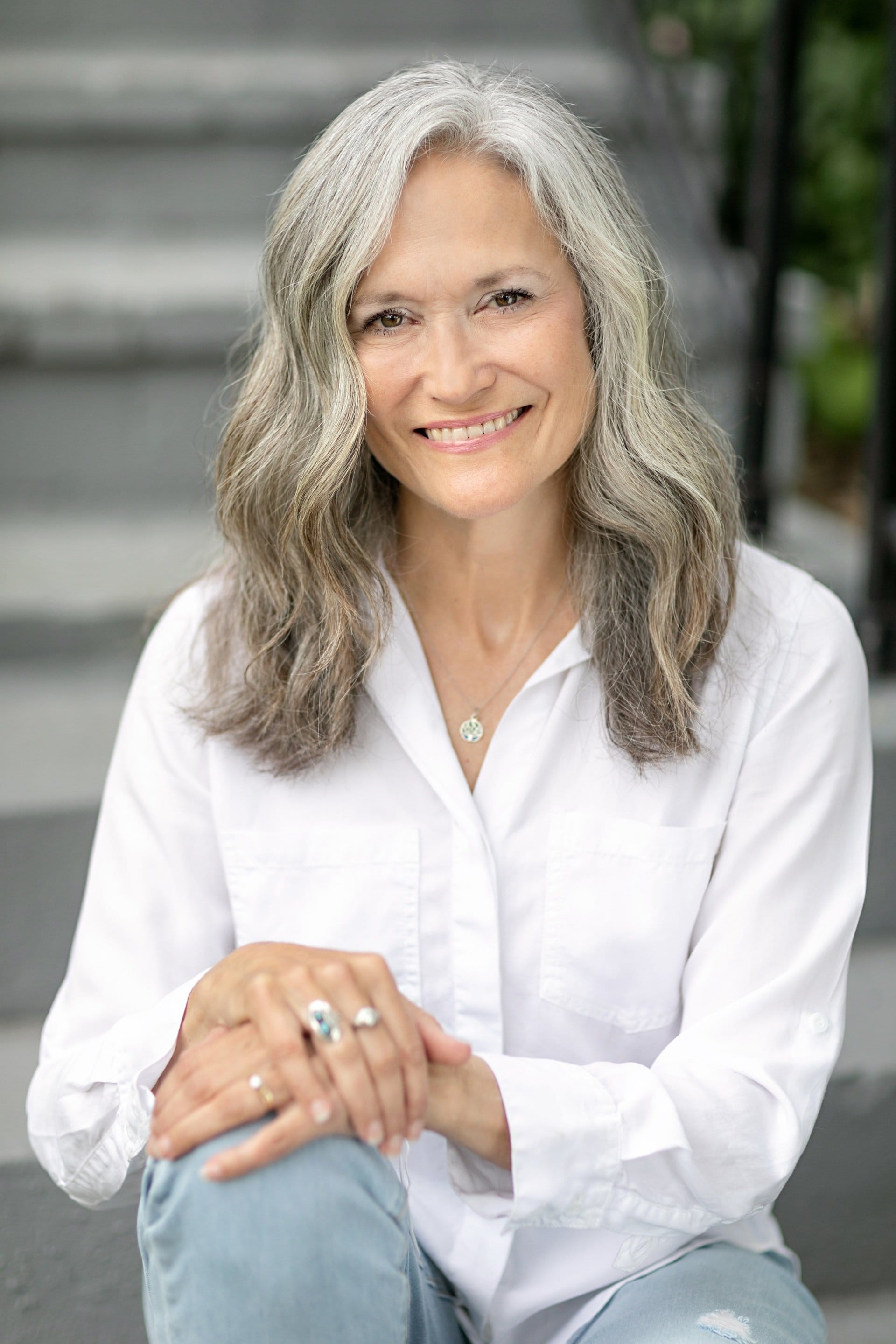
She earned a Bachelor of Journalism degree from the University of Missouri, graduating summa cum laude, and later received an MFA in Fiction from Warren Wilson College in Asheville, North Carolina, in 2013. Before turning to fiction, Anderson spent fifteen years as a copywriter in advertising and public relations agencies in cities including St. Louis, Palo Alto, Denver, and Houston, then transitioned to freelance work and teaching. She has taught at the University of Missouri and Stephens College and has also taught creative writing at the elementary school level.
Her short fiction has appeared in numerous publications such as Nimrod International Journal, Literal Latté, Midwestern Gothic, Elder Mountain: A Journal of Ozarks Studies, Bosque, The Lascaux Review, Pooled Ink, Storied Hills: An Anthology of Contemporary Ozark Fiction, and others. Anderson also serves on the board of The Missouri Review.
Currently, Michelle Collins Anderson lives in St. Louis, Missouri, with her husband, Clay, in a historic brick row house. They have three adult children, two cats, and a border collie.
The Flower Sisters is inspired by a real-life tragedy: the 1928 Bond Dance Hall explosion in West Plains, Missouri, which killed 39 people and injured 22 more. The event and its aftermath serve as the foundation for her novel, which explores themes of community, secrets, and redemption.

Here are several notable quotes from The Flower Sisters by Michelle Collins Anderson:
"Sometimes I think spring lasts about fifteen minutes around here and then we're all sitting on Hell's front porch."
This line captures the novel's wry, regional sense of humor and the atmosphere of its Ozarks setting.
"You can’t change where and who you’ve come from, only where you will go and who you will be. But that place and those people always call your name."
This quote reflects one of the book’s central themes: the tension between heritage and self-determination.
"Because home is a feeling, and the people and place that inspire that feeling."
The novel often explores the idea of home as something more emotional than physical, a recurring motif in Daisy’s journey.
"I’ve read a lot about it, and the experts say that identical twins often know what the other is thinking or feeling or about to do without being told."
This line hints at the close, sometimes mysterious bonds between characters, especially among family.
"My father could not believe that he was the inspiration for that happiness, that light."
This introspective moment highlights the complexity of family relationships and the unexpected ways people affect each other.
"Write the truth, but make sure the truths you write are yours to tell."
Spoken as advice to Daisy, this line underscores the ethical dilemmas faced by storytellers and journalists in the novel.
"The sun always comes up, making everything new and hopeful. Everyone knows that. The trick is to see the beauty in the dark while you are still in it."
This quote, spoken by Rose, is emblematic of the book’s message about resilience and finding hope even during difficult times.

The Flower Sisters is a historical novel deeply rooted in a real-life tragedy: the Bond Dance Hall explosion that occurred in West Plains, Missouri, on April 13, 1928. The novel fictionalizes this event, changing some names and details, but draws heavily from the facts and lingering mysteries surrounding the disaster.

Key Historical Facts Behind the Novel
- Real Event: The inspiration for the novel is the explosion at the Bond Dance Hall in West Plains, Missouri. On that night in 1928, an explosion ripped through the dance hall, killing 39 people—many of them young adults. The cause of the blast remained undetermined, and some victims remained undiscovered.
- Ongoing Mystery: The true cause of the explosion remains unknown to this day, contributing to the sense of unresolved trauma and secrecy that permeates both the real event and its fictional counterpart.
- Community Impact: The tragedy left a deep scar on the small Ozarks town, with survivors and families of the victims carrying the emotional and social consequences for generations. The event was so traumatic that, for decades, the community was reluctant to discuss it openly, fostering an atmosphere of suppressed grief and secrecy.
- Fictionalization: In the novel, Anderson renames the town to "Possum Flats" and the dance hall to "Lamb’s Dance Hall," but the core incident—a catastrophic fire/explosion killing dozens—remains true to the historical record.
How the Novel Interweaves History
- Dual Timeline: The story alternates between 1928, focusing on the twin sisters Violet and Rose Flowers, and 1978, when their granddaughter Daisy investigates the long-buried tragedy.
- Family and Community Secrets: Daisy’s investigation into the dance hall fire uncovers not only her family’s connection to the event but also the broader web of secrets, cover-ups, and unresolved guilt that have haunted the town for fifty years.
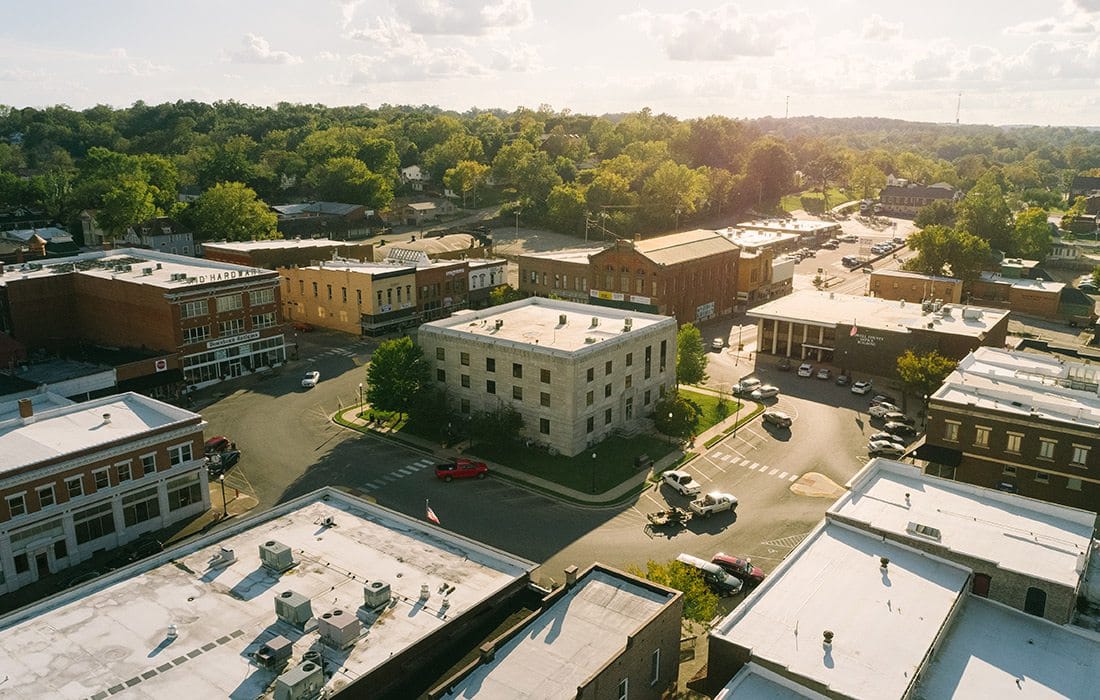
Author’s Connection: Michelle Collins Anderson grew up in West Plains, Missouri, and was inspired by the real-life stories and the enduring silence surrounding the Bond Dance Hall explosion in her hometown.

Author’s Connection: Michelle Collins Anderson grew up in West Plains, Missouri, and was inspired by the real-life stories and the enduring silence surrounding the Bond Dance Hall explosion in her hometown.

For a book club meeting themed around The Flower Sisters, consider decor that captures the novel’s Ozark small-town setting, floral motifs, and the dual timelines of 1928 and 1978. Here are some creative, book-inspired decorating ideas:
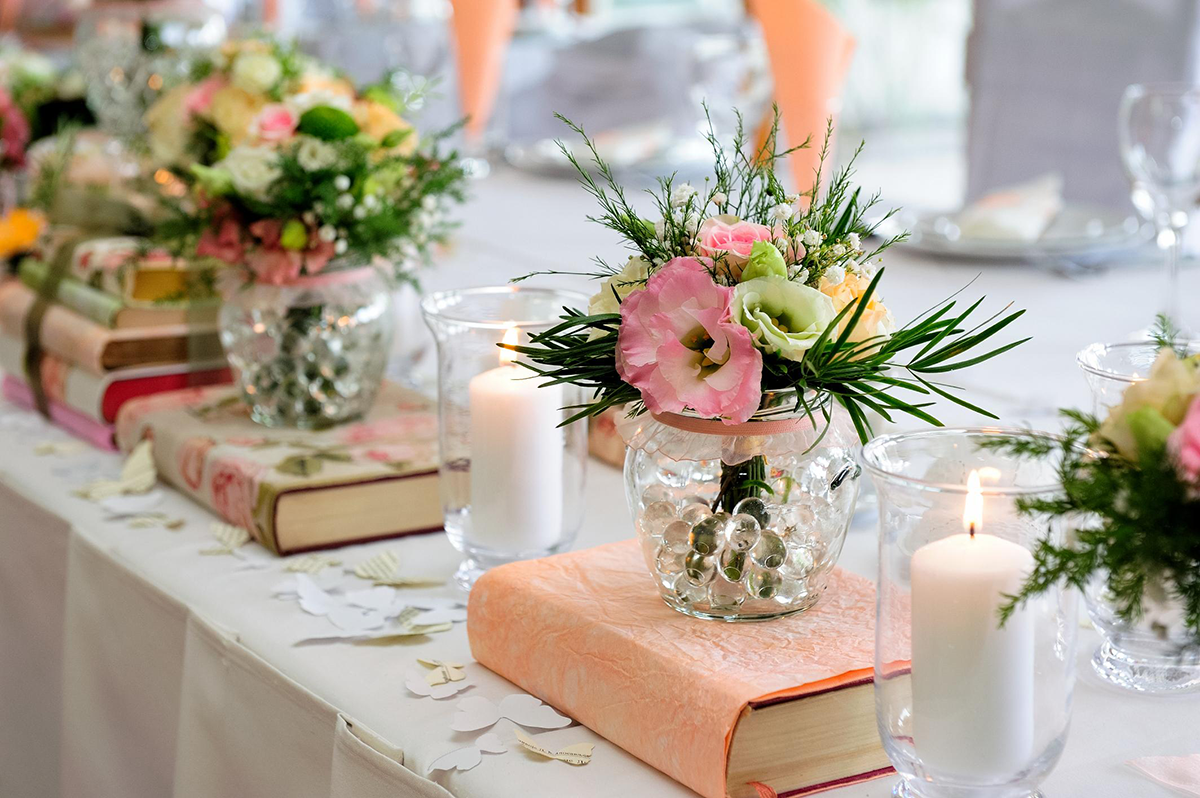
Floral Centerpieces and Arrangements
- Create centerpieces with a mix of wildflowers and vintage-style vases to evoke the Missouri countryside and the “Flower Sisters” themselves. Use flowers that might be found in the Ozarks—think daisies, violets, and roses, nodding to the sisters’ names and the book’s title.
- Incorporate subtle touches like sprigs of greenery, dried flowers, or even teacup arrangements for a nostalgic, homey feel.
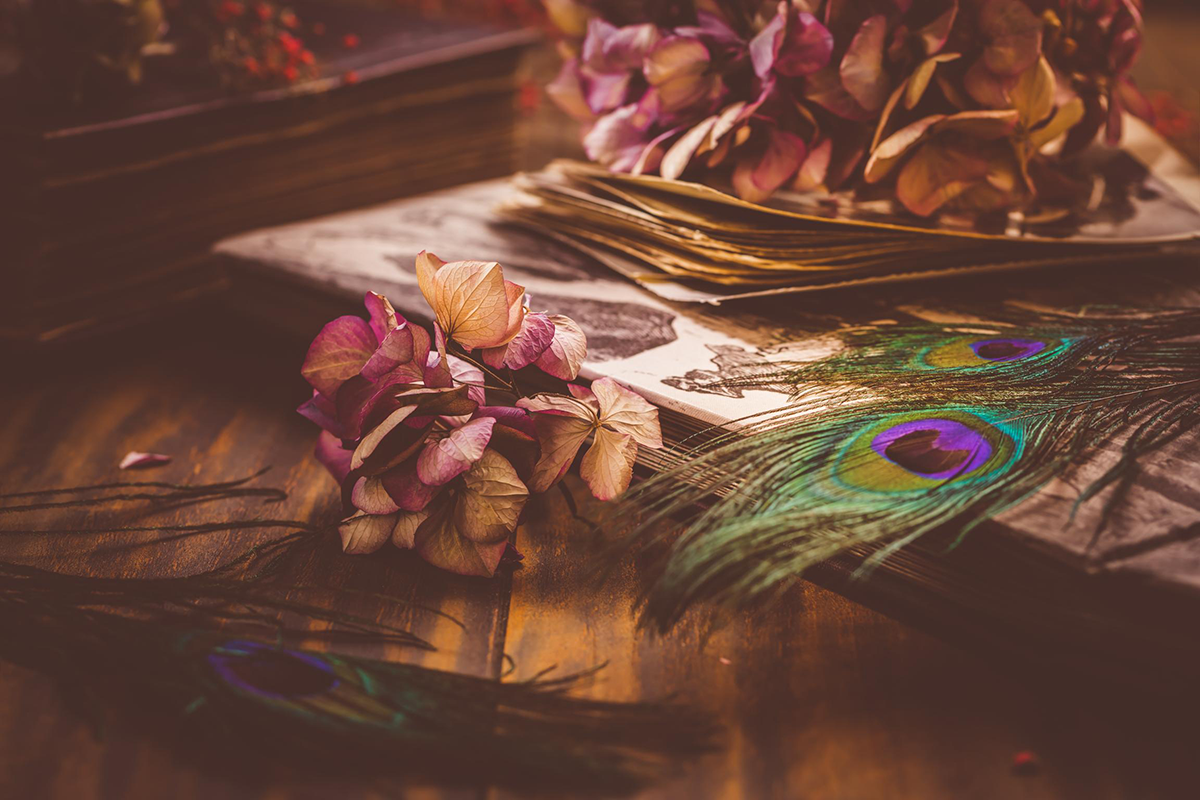
Vintage and Period Touches
- Use lace tablecloths, mason jars, and old-fashioned glass bottles as vases to reflect the 1920s and 1970s periods in the book.
- Scatter a few vintage books, old newspapers, or typewriter props to hint at Daisy’s work as a budding journalist in 1978.
Memorial and Remembrance Elements
- Set up a small “memorial” display inspired by the novel’s themes of remembrance and the dance hall tragedy. This could include framed black-and-white photos (real or printed from stock images), candles, or a simple plaque with a quote about memory or resilience.
- Invite guests to write a memory or a wish on a paper flower and add it to a communal bouquet, symbolizing the community’s healing and shared stories.
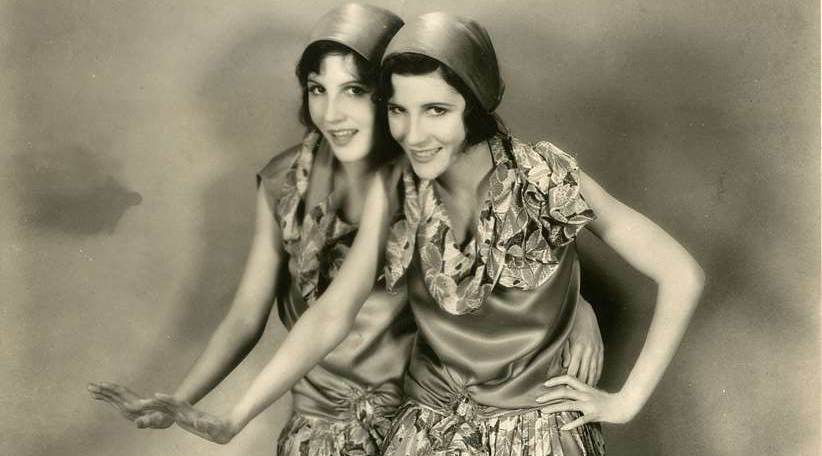
Subtle Symbolism
- Incorporate twin motifs (mirrored decor, paired candles, or napkin rings) to represent Rose and Violet, the identical sisters at the heart of the story.
- Use signage or place cards with typewriter fonts or hand-lettered styles to evoke Daisy’s investigative work and the novel’s historical feel.
Atmosphere and Ambience
- Play soft jazz or period-appropriate music in the background to evoke the dance hall setting.
- Dim the lights and use string lights or lanterns to create a warm, inviting space reminiscent of a small-town gathering spot.

- "Favorite Flower" Icebreaker Activity (In printable kit)
- "Extend the End" Game (In printable kit)
- "Extreme Makeover: Modern Flower Sisters" Icebreaker Activity (In printable kit)
- Book Group Quiz: Flower Sisters Edition (In printable kit)

For a book club meeting featuring The Flower Sisters you can create a menu that reflects both the novel’s themes—family, memory, and the bonds between sisters—and its evocative title. While the search results do not provide specific foods mentioned in the novel, you can draw inspiration from the book’s atmosphere and general book club menu traditions.
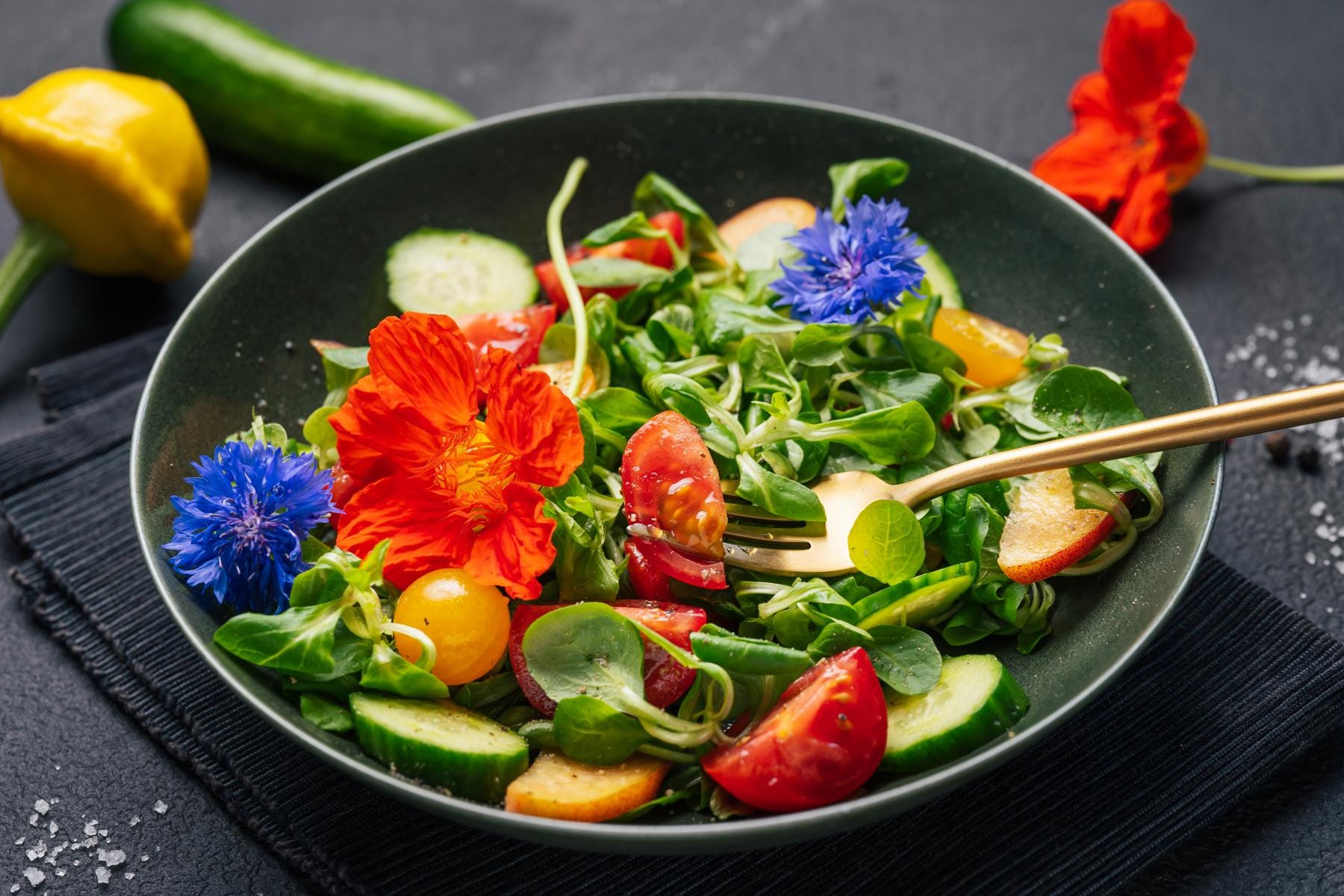
Floral & Garden-Inspired Dishes
- Edible flower salad: Mixed greens with edible flowers (like nasturtiums or violets), goat cheese, and a light vinaigrette.
- Herbed tea sandwiches: Cucumber, dill, and cream cheese on soft bread, cut into flower shapes.
- Lavender shortbread cookies: Buttery cookies with a hint of lavender for a subtle floral note.
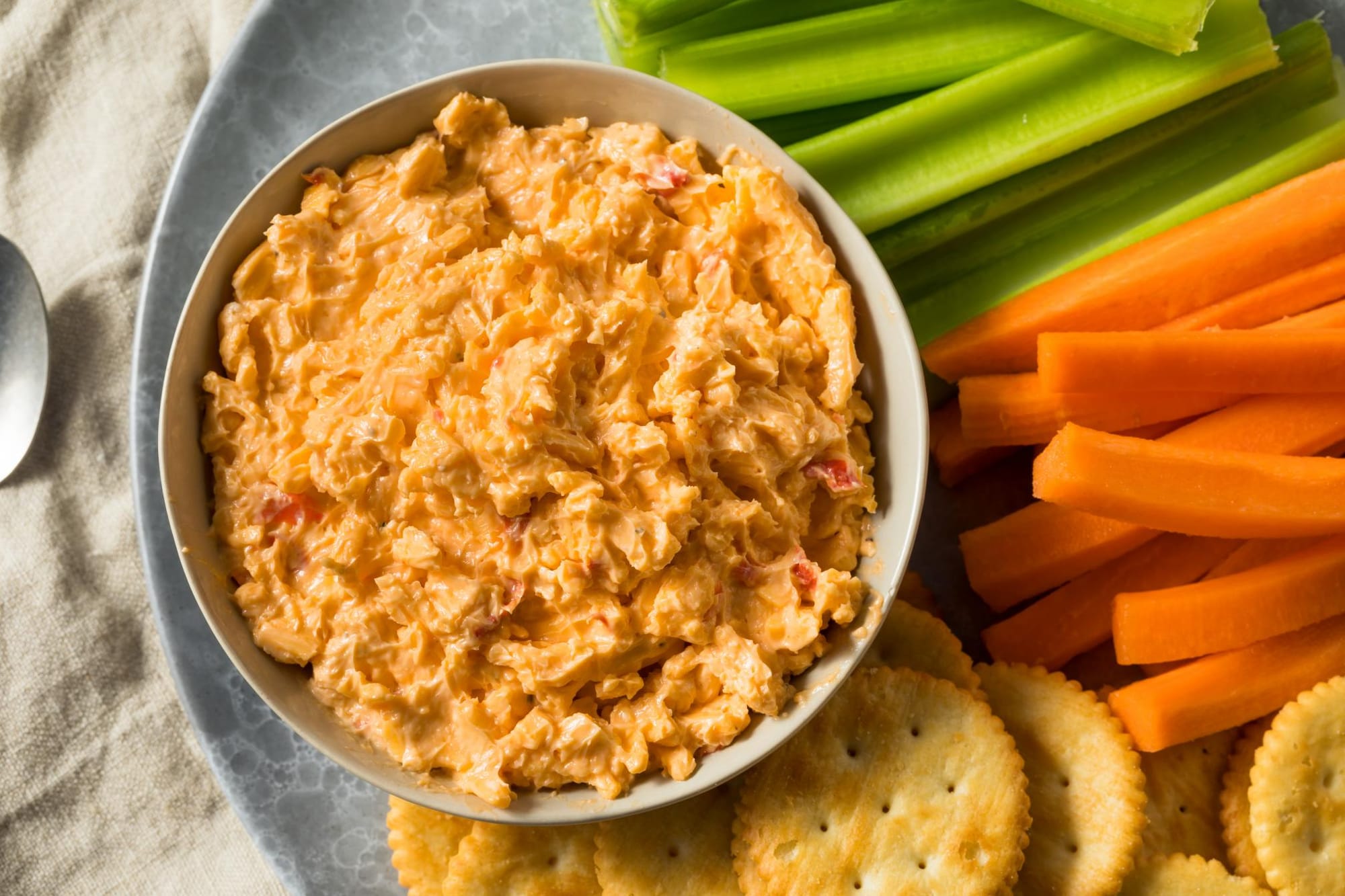
Southern Comfort (if the novel’s setting or mood evokes the American Midwest or South)
- Pimento cheese dip with crackers or crostini.
- Deviled eggs with a sprinkle of paprika and chives.
- Mini chicken salad croissants.
Colorful, Sisterly Sharing Plates
- Charcuterie board: Assorted cheeses, cured meats, fresh fruit, and marinated olives for easy sharing.
- Caprese skewers: Cherry tomatoes, mozzarella balls, and basil leaves drizzled with balsamic glaze.
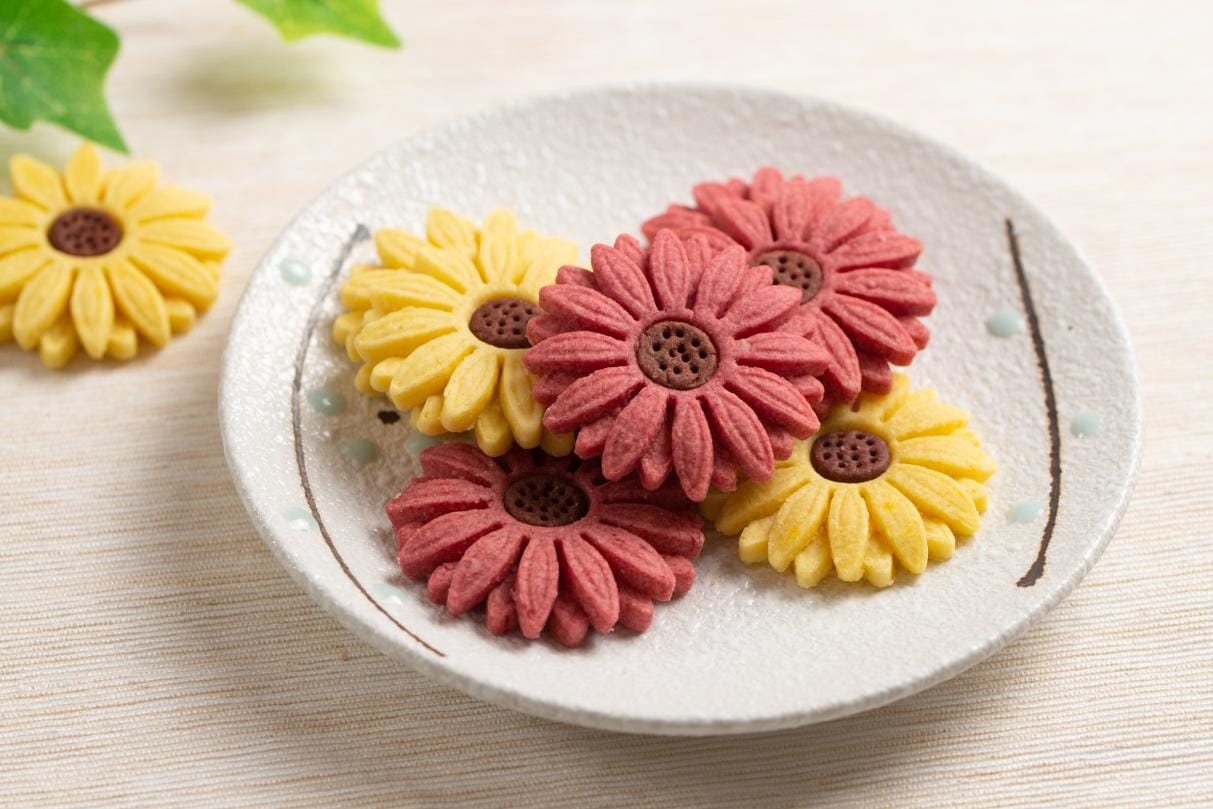
Desserts
- Flower-shaped sugar cookies decorated with pastel icing.
- Berry trifle: Layers of sponge cake, whipped cream, and fresh berries in a clear bowl.
Beverages
- Herbal iced tea: Such as hibiscus or chamomile, served with lemon slices.
- Champagne punch: A festive option with sparkling wine, cranberry juice, and floating edible flowers.
- Sweet tea: For a Southern touch, as many book clubs enjoy.
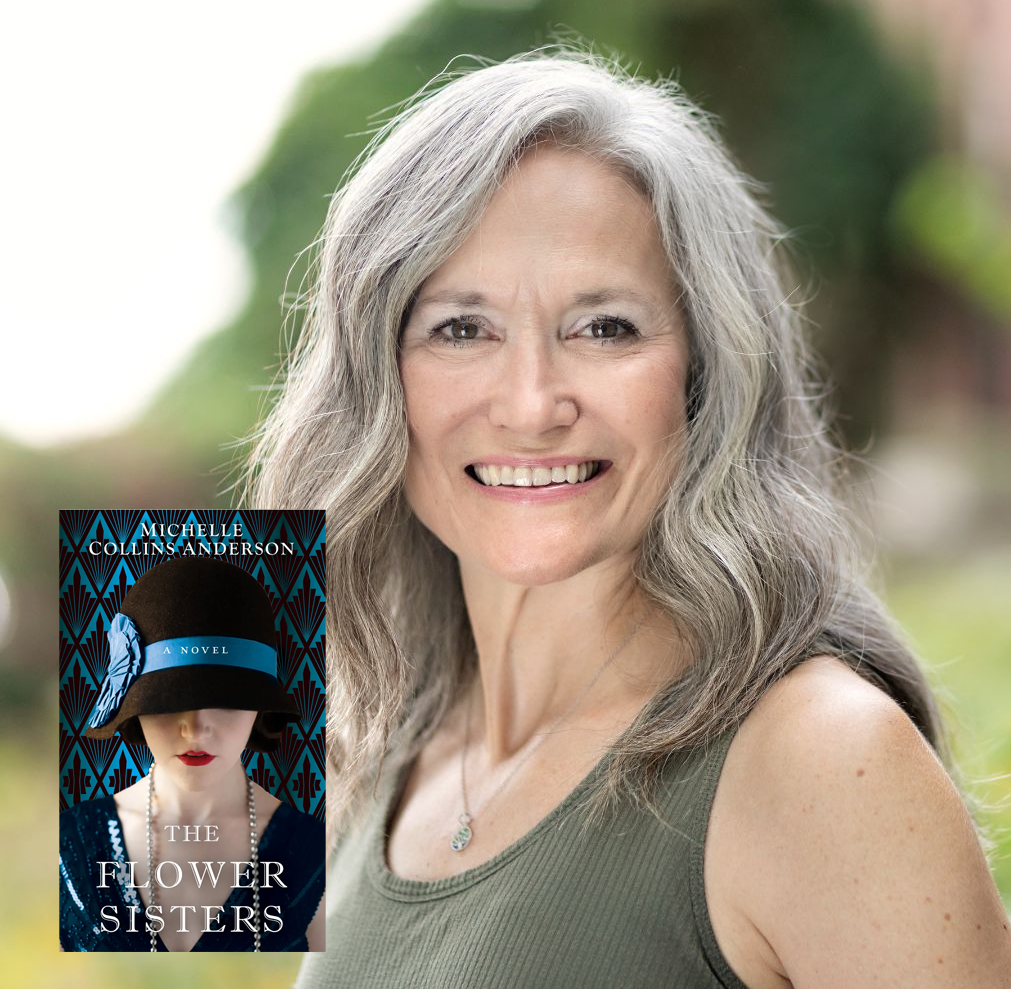
Get Michelle Collins Anderson books
A wonderful slice of 1920s Americana based on true events.
Bookshop.org was created as a socially conscious alternative to Amazon, with the goal of helping local, independent bookstores thrive. This is why Readers With Wrinkles supports their efforts. Please join us in this effort by purchasing your next read here.
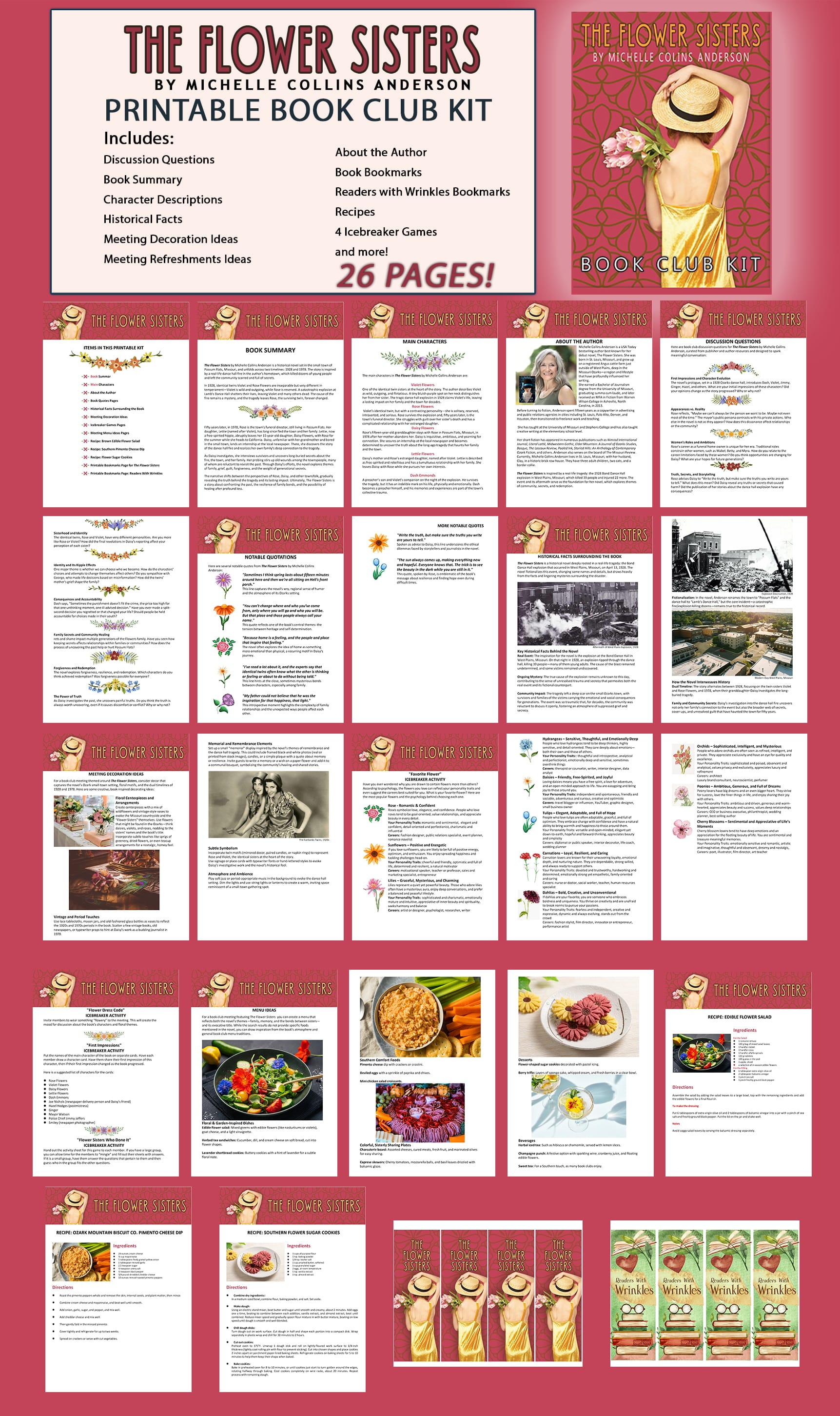
The Flower Sisters printable BOOK CLUB KIT
The RWW book club kits provide everything you need to organize a great meeting with insightful discussions. These resources simplify book club preparation with character lists, book quotes, refreshment suggestions, recipes, and carefully prepared book club questions!

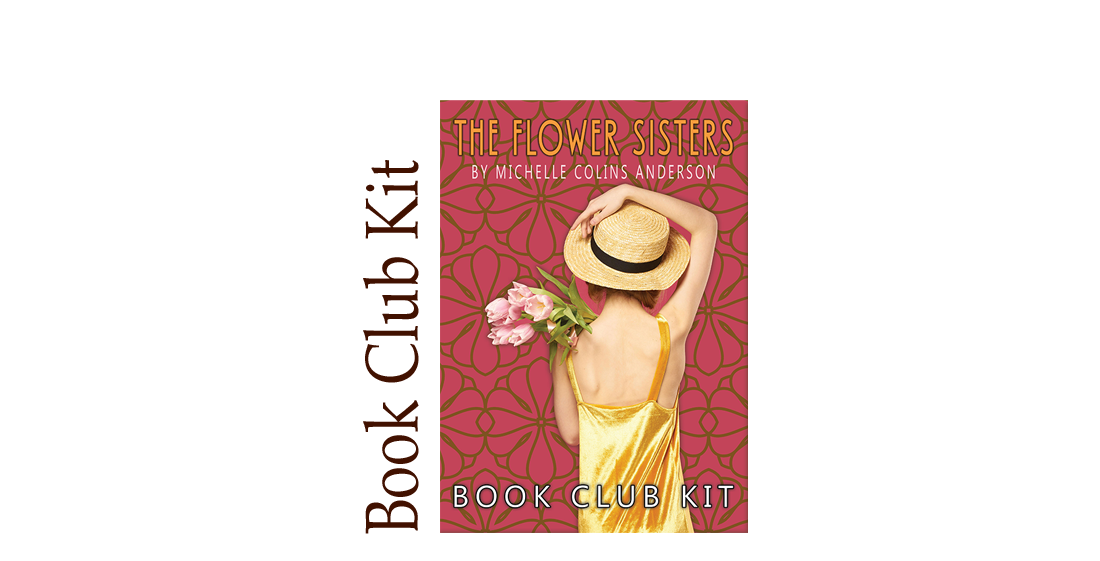
Comments